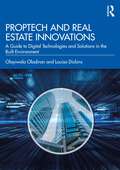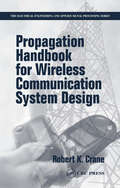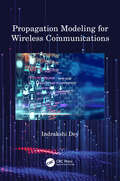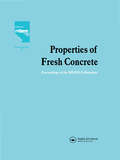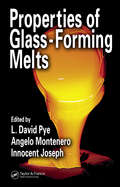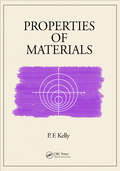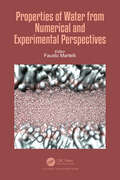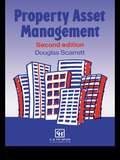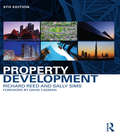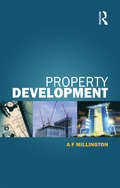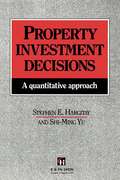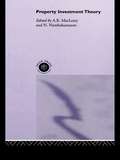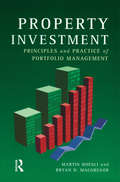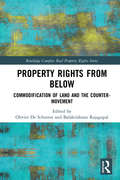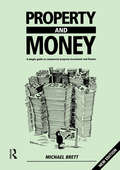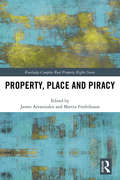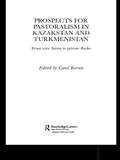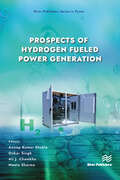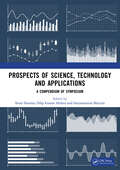- Table View
- List View
Promotion of Work Ability towards Productive Aging: Selected papers of the 3rd International Symposium on Work Ability, Hanoi, Vietnam, 22-24 October 2007
by Masaharu KumashiroThis publication is a collection of selected papers from the 3rd International Symposium on Work Ability Promotion of Work Ability Towards a Productive Aging.It addresses the Work Ability Index (WAI) as an index for evaluating work ability, developed by the Finnish Institute of Occupational Health as a tool for evaluating work ability of workers. T
PropTech and Real Estate Innovations: A Guide to Digital Technologies and Solutions in the Built Environment
by Olayiwola Oladiran Louisa DickinsThis textbook serves as a guide to real estate students and educators on the various property innovations and digital technologies that continue to shape the property industry. The advancement of PropTech in the last few decades has led to significant changes in real estate systems, operations, and practice, and this new textbook provides insight on the past, present, and future of PropTech innovations that have spread across the value chain of real estate through planning, development, management, finance, investment, operations, and transactions. The textbook approaches this subject from the real estate components, asset classes, and submarkets and links them to the associated innovations and digital technologies. It concludes by reviewing the role of education, innovation, skill development, and professionalism as major elements of the future of real estate operations and practice.This book’s unique contributions are in putting the “property” element at the forefront and then illustrating how technology can enhance the various areas of real estate; the focus on how the different innovations and technologies can enhance the economic, environmental, social, and physical efficiency of real estate; and its coverage of some non‑technological innovations like flexible working and more practical areas of real estate innovation such as skills, employability, creativity, and education.It contains 21 case studies and 29 case summaries, which can serve as practice exercises for students. This book will be useful to students in helping them build a knowledge base and understanding of innovation and digital technologies in the industry. Real estate educators can use the textbook as a guide to incorporate real estate innovation and digital technologies into their current teaching and also to develop their real estate curricula through PropTech‑related modules and courses where necessary. It will also be valuable to real estate researchers in search of the theoretical and conceptual linkages, as well as industry practitioners who seek insight into the current and future potential of digital technologies and their applications to real estate operations and practice.
Propagation Handbook for Wireless Communication System Design (Electrical Engineering & Applied Signal Processing Series)
by Robert K. CraneData and models for better systems designAtmospheric gases, building materials, the weather � The propagation of wireless communications signals depends upon a whole range of factors, any or all of which can have a significant impact on the quality of a signal. Data generated by careful measurement of signals propagating under various envir
Propagation Modeling for Wireless Communications
by Indrakshi DeyThis book introduces the various approaches and tools used for modelling different propagation environments and lays the foundation for developing a unified theoretical framework for future integrated communication networks. In the case of each type of network, the book uses basic concepts of physics, mathematics, geometry and probability theory to study the impact of the dimension and shape of the propagation environment and relative transmit-receive position on the information flow. The book provides an introduction into wireless communication systems and networks and their applications. For both systems and networks, the basic hard (encoder, modulator, etc.) and soft components (information, signal, etc.) are discussed through schematic block diagrams. Next each of the modes of communication, namely radio waves, acoustic waves, magnetic induction, optical waves, biological particles (molecules, aerosols, neural synapse etc.) and quantum field, are discussed. For each communication scenario presented, the impact of different environmental factors on the propagation phenomenon is articulated, followed by different channel modelling (deterministic, analytical, and stochastic) techniques that are used to characterize the propagation environment. Finally future trends in wireless communication networks are examined and envisioned for next generations 6G/7G of communication systems, like space information networks, sea-to-sky internet of vehicles, and internet of bio-nano things. Based on the future trends of integrated networks, the book drives the need for a generalized channel model irrespective of the media and mode of information transfer. The primary audience for the book is post-graduate students, researchers and academics in electronics and communications engineering, electrical engineering and computer science.
Properties of Fresh Concrete: Proceedings of the International RILEM Colloquium
by H. J. WierigThis book presents new information on concrete properties and production in the light of the widespread use of ready mixed concrete and new concreting materials. This book forms the Proceedings of the RILEM Colloquium held in Hanover, West Germany in October 1990. Papers from 18 countries in Europe, North America and the Far East are included.
Properties of Glass-Forming Melts
by L. David Pye Angelo Montenero Innocent JosephThis book presents state-of-the-art information concerning properties and processes involved in glass melts. Based upon contributions by renowned authors and scientists working with glass melt systems, Properties of Glass-Forming Melts is an excellent compilation of the current knowledge on property data, mechanisms, measurement techniques, and str
Properties of Materials
by P.F. KellyThe second volume in the author's three-part series, Properties of Materials uses the principles of classical mechanics to qualitatively and quantitatively model specific features of matter.The text develops linear models of elasticity to correlate and quantify the changes in an object's shape induced by the application of a constant force. It desc
Properties of Water from Numerical and Experimental Perspectives
by Fausto MartelliAs the most important liquid in our life and one of the most abundant molecules in the universe, water is the least understood substance with a very rich phase diagram (at least 18 crystalline forms and two liquids) and more that 60 dynamical/thermodynamic anomalies whose origins are still under debate. Properties of Water from Numerical and Experimental Perspectives gathers together leading scientists and experts in the field of water. By merging the theoretical/computational point of view with experimental approaches, it presents a state-of-the-art description of the properties of water, enlightening the source of the anomalies of water and describing how such anomalies actively affect the functioning of biological substances.
Property Asset Management
by D. ScarrettProperty has unique characteristics, both as an investment and as an operational holding. A thorough understanding of this dual role is needed by professionals responsible for maximising a property's full potential. Property Asset Management emphasizes the need for a strategic plan in property management as well as for efficient day-to-day practice.
Property Asset Management
by Douglas Scarrett Jan WilcoxProperty asset management requires both day-to-day oversight of rental properties and an ability to maximize the potential of the portfolio through forward thinking and practical planning. Successful property managers must be flexible and proactive whilst maintaining a robust knowledge of technical, financial and legal aspects of the leasing system. Property Asset Management is a practical guide to the key principles of successful property management, perfect for both student and practitioner alike. In this book, Douglas Scarrett and Jan Wilcox demonstrate how to successfully manage properties for the varying needs of clients ranging from individual property owners to large international commercial ventures. As well as the basic theory, Property Asset Management discusses the process of active management, the strategic objectives, performance measurement, and the key financial and operational information needed for high quality and comprehensive reporting to clients. This fourth edition has new chapters on corporate real estate and financial management, and has been extensively rewritten to incorporate recent developments in property management. Software screenshots are used to illustrate salient points and readers are provided with a thorough overview of the latest legal aspects of land ownership and tenancy arrangements. With everything you need for successful property asset management, this book both caters for the needs of RICS accredited and business courses and serves as a handy guide for everyday practice.
Property Development
by Richard Reed Sally SimsThe 6th edition of this extremely popular and classic textbook has been updated to reflect ongoing changes in the field of property development. Attention is paid to the impact of the global financial crisis on the property development process and, in addition, to the increasing relevance of technology to the property profession. Whilst the successful style and format of the text has been retained, new chapters have been added and existing chapters updated and enhanced to guide lecturers and students in their teaching, reading and studying. Other new features in this edition include: Fully updated discussion points and reflective summaries Examples of contemporary best practice based on international case studies covering the UK, USA and Australia New chapters on 'Property Cycles' and 'Technology' Online materials for lecturers and students This fully revised edition of a standard text for all property development and real estate students will also be of interest to early career professionals and those pursuing similar professional degrees in the industry and in wider built environment courses.
Property Development
by Alan Millington"Property Development" includes such considerations as the objectives, functions, roles and methods of operation of all those involved in the development process, the financial aspects of development, social considerations, planning matters, and others, providing readers with the opportunity to develop their understanding of and their expertise in, the subject.
Property Investment Decisions: A quantitative approach
by S. Hargitay S Hargitay S-M YuThe importance of property as an investment medium continues to grow. Investors in property or those involved with the provision of expert advice to investors have had to improve the effectiveness and efficiency of their decision making. The aim of this book is to lay down the theoretical foundations of investment decision making, incorporating the techniques and procedures of modern management science, so that particular decisions regarding property investment can be made efficiently and rationally.
Property Investment Theory
by A. R. MacLeary N. NanthakumaranThis up-to-date reference on property investment highlights the problems with existing techniques of property valuation and appraisal and identifies possible ways forward for both research and practice.
Property Investment: Principles and Practice of Portfolio Management
by Martin Hoesli Bryan D. MacgregorProperty investment markets and applied property research are now recognised as an increasingly important international phenomenon. Written by two of the most respected academics in the field, this authoritative guide provides a fresh and much needed perspective on this important subject. The book examines the unique characteristics of property investment within the context of other capital markets . The emphasis is strongly on the application of analytical tools from other markets to help academics and practitioners alike understand and apply the investment management of property with that of other asset classes. The book is split into three parts, each focusing mainly on direct commercial property: The characteristics of the various asset classes in the investment background The analyses necessary to develop a property portfolio strategy An examination of property in a wider context This book will be invaluable to all undergraduate and postgraduate students on property courses worldwide. It is also an essential tool to understanding this complex and exciting field for students on finance, business and accountancy courses which cover property. Its practical, applied approach means that the book will be a welcome addition to the bookshelf of any researchers or investment managers with an interest in property.
Property Rights and Climate Change: Land use under changing environmental conditions (Routledge Complex Real Property Rights Series)
by Thomas Hartmann Fennie Van Straalen John SheehanProperty Rights and Climate Change explores the multifarious relationships between different types of climate-driven environmental changes and property rights. This original contribution to the literature examines such climate changes through the lens of property rights, rather than through the lens of land use planning. The inherent assumption pursued is that the different types of environmental changes, with their particular effects and impact on land use, share common issues regarding the relation between the social construction of land via property rights and the dynamics of a changing environment. Making these common issues explicit and discussing the different approaches to them is the central objective of this book. Through examining a variety of cases from the Arctic to the Australian coast, the contributors take a transdisciplinary look at the winners and losers of climate change, discuss approaches to dealing with changing environmental conditions, and stimulate pathways for further research. This book is essential reading for lawyers, planners, property rights experts and environmentalists.
Property Rights from Below: Commodification of Land and the Counter-Movement (Routledge Complex Real Property Rights Series)
by Olivier De Schutter Balakrishnan RajagopalRecent years have seen a globalization of property rights as the Western conception of property over land has extended across the world. As formerly community-owned land and natural resources are privatized and titling schemes proliferate, Property Rights from Below questions the trend toward treating land as a commodity and explores alternatives to the Western model. As we enter an era of resource scarcity and as competition for land and associated natural resources increases, purchasing power cannot become the sole criterion for land allocation; and the law of supply and demand in increasingly financialized markets cannot become the sole metric through which the value of land is determined. Using a range of examples from around the world, Property Rights from Below demonstrates that alternatives to this model often emerge from social innovations supported by local communities and that there is an urgent need for a broader political imagination when it comes to land governance. This innovative cross-disciplinary perspective on the pressing problems surrounding global property rights will be of interest to academics, students and professionals with an interest in property law, development economics and land governance.
Property Rights in Outer Space: Mining, Techno-Utopian Imaginaries, and the Privatisation of the Off-World Frontier (Routledge Complex Real Property Rights Series)
by Matthew JohnsonThis book explores the role of private mining rights in the utopian imaginary of space colonisation. It presents a transdisciplinary account of the new and evolving legislative frameworks that have been established in anticipation of commercial exploitation of the mineral resources of the off-world frontier. Written in an engaging style, the book investigates a novel case study in the history of capitalism and 'the commons': the emergence of a nascent space mining industry, undergirded by a contentious legislative framework. In 2015, the US passed laws that would recognise the claims of US corporations to own and sell space resources. This unilateral act of pre-emptive law-making would appear to contravene the terms of the UN Outer Space Treaty (1967), which declared that the exploration and use of outer space should be ‘for the benefit of all mankind’ and ‘not subject to national appropriation’.Using this central dynamic between privately held mining rights and outer space as a 'global commons', Matthew Johnson constructs an historical sociology of space mining – from the deep historical roots of common and private property to the contemporary networks of neoliberalism that have engaged with the commercialisation of space activity. The anticipatory expansion of private property claims beyond the Earth both resonates with and problematises the ‘terrain’ of political history, such as the tensions between states and markets, public law and private power, ‘the commons’ and exclusive property. The emerging cosmopolitics of off-world private property mirrors (and is often explicitly embedded within) neoliberal geopolitics, prompting urgent questions about how we can reaffirm principles of democracy and ‘common heritage’ in the international laws of Earth and space. This book is compelling reading for anyone interested in the social study of space, law, economics, technology, politics and property rights.
Property Valuation: The Five Methods
by Sylvia Osborn Douglas ScarrettThe third edition of Property Valuation: The Five Methods introduces students to the fundamental principles of property valuation theory by means of clear explanation and worked examples. An ideal text for those new to the subject, the book provides 1st year undergraduate students with a working knowledge and understanding of the five methods of valuation and the ways in which they are interlinked.In this fully revised edition, the new author team have: restructured the chapters to ensure a more logical order outlined the economic theory of value and the rules and constraints under which a valuer works provided detailed consideration of each of the five recognised approaches placed a larger emphasis on the Discounted Cash Flow approach These revisions are all written in the concise and accessible style which has made previous editions of the book so successful. The new edition of this textbook will be essential reading for undergraduates on all property, real estate, planning and built environment courses.
Property and Money
by Michael BrettProperty and Money is a simple guide to the investment and financial aspects of commercial property. Putting property into its financial context, it seeks to bridge the world of the surveyor and property developer and the investment and financial markets of the City of London.The book starts from first principles, assuming no pre-existing knowledge. It is thus suitable for students as well as more established property practitioners and its appeal extends to bankers, solicitors, accountants and fund managers whose work brings them into contact with commercial property transactions. This updated and expanded edition includes coverage of: - Principles and pitfalls of property finance - How the property investment market works - Evaluating property and its performance - Understanding property companies and their accounts - How property companies get into trouble - Bank loans, bonds, profit-share agreements, leasebacks and other methods of property finance - The crash of the early 1990's and its consequences.Based on a widely acclaimed series of articles that appeared in Estates Gazette magazine, Property and Money is complemented by an extensive index and glossary and enlivened by Nick Newman's cartoonist-eye view of the property world.
Property, Place and Piracy (Routledge Complex Real Property Rights Series)
by Martin Fredriksson James ArvanitakisThis book takes the concept of piracy as a starting point to discuss the instability of property as a social construction and how this is spatially situated. Piracy is understood as acts and practices that emerge in zones where the construction and definition of property is ambiguous. Media piracy is a frequently used example where file-sharers and copyright holders argue whether culture and information is a common resource to be freely shared or property to be protected. This book highlights that this is not a dilemma unique to immaterial resources: concepts such as property, ownership and the rights of use are just as diffuse when it comes to spatial resources such as land, water, air or urban space. By structuring the book around this heterogeneous understanding of piracy as an analytical perspective, the editors and contributors advance a trans-disciplinary and multi-theoretical approach to place and property. In doing so, the book moves from theoretical discussions on commons and property to empirical cases concerning access to and appropriation of land, natural and cultural resources. The chapters cover areas such as maritime piracy, the philosophical and legal foundations of property rights, mining and land rights, biopiracy and traditional knowledge, indigenous rights, colonization of space, military expansionism and the enclosure of urban space. This book is essential reading for a variety of disciplines including indigenous studies, cultural studies, geography, political economy, law, environmental studies and all readers concerned with piracy and the ambiguity of property.
Prospects and Utilization of Tropical Plantation Trees
by Kang Chiang LiewLarge numbers of tropical trees from natural forests or plantation forest are available for human consumption and management. This book focuses on the prospects and utilization of tropical plantation trees in context of economic and business, planting, managing stocks, and uses of trees converted to various wood-based products. It provides information on key areas of tropical plantation trees including growth performance, nursery practices, soil properties, planting stock production, raw material cellulose, anatomy, pulping and papermaking, fiber modification, and properties of wood composites. Features: Comprehensive information on prospects and utilization of tropical plantation tree species. Features information on potential products derived from tropical plantation trees including cellulose-based wood products, particleboard with bioplastic binder, and laminated veneer lumber. Discusses species usage of economic importance other than wood production. Presents information on nursery practices, growth performance, and soil properties of tropical trees. Illustrates methodologies for repeating investigations on work that has been done previously in tropical tree research. This book introduces information for entrepreneurs or researchers before undertaking work with these tree species illustrating technical methodologies allowing for repetition or previous successful works. This information proves valuable to researchers if further work is needed for improvement on these plant-derived products.
Prospects for Pastoralism in Kazakstan and Turkmenistan: From State Farms to Private Flocks (Central Asia Research Forum)
by Carol KervenThis collection traces how pastoralists have coped with the challenges of change in a part of the world with a long-tradition of livestock keeping. Their precarious position - balanced between a market system where only the fittest may survive, and their attempt to remain a human resource for the future development of the natural pastures and livestock industry - is carefully and critically examined by the contributors. The pastoralists' unique skills at managing livestock in a variable and challenging environment, and their ability to supply commodities much in demand mean that an understanding of their societal position is essential for anyone interested in transition in the former Soviet Union.
Prospects of Hydrogen Fueled Power Generation (River Publishers Series in Power)
by Anoop Kumar Shukla Onkar Singh Meeta Sharma Ali J. ChamkhaProspects of Hydrogen-fueled Power Generation brings together experts to explore the various challenges and opportunities of hydrogen as a fuel in power generation, transportation, storage, and safety. Special interest is given to proton exchange membrane fuel cell (PEMFC) fuel cells, hydrogen energy, and the conversion methods. The usage of clean fuel in road transportation, marine transportation, and the power generation sector are also discussed in detail. Additionally, performance investigations reveal information about the system's energy and exergy analysis.Hydrogen-fueled power generation is the process of generating electricity using hydrogen as the primary fuel source. This process typically involves the conversion of hydrogen into electricity using fuel cells or combustion engines. Fuel cells are electrochemical devices that convert hydrogen into electricity and water with no emissions other than water vapor. Combustion engines, on the other hand, burn hydrogen to produce heat, which is used to generate electricity through a turbine. The byproducts of hydrogen combustion are water and heat, with no harmful emissions. One advantage of hydrogen-fueled power generation is that it produces no harmful emissions, making it a clean and sustainable source of energy. Additionally, hydrogen is a highly abundant element that can be produced from a variety of sources, including natural gas, biomass, and renewable energy sources like solar and wind power.
Prospects of Science, Technology and Applications
by Renu Sharma Satyanarayan Bhuyan Dilip Kumar MishraIn the rapidly evolving landscape of scientific and technological advancements, the “Prospects of Science, Technology, and Applications: A Compendium of Symposium” endeavors to explore the dynamic future that awaits us. As we stand at the crossroads of innovation and discovery, the need for a comprehensive understanding of the potential trajectories and applications in science and technology has never been more crucial. This compilation brings together insights from esteemed contributors who are experts in their respective fields, ranging from fundamental sciences to cutting-edge technologies. The diverse perspectives offered within these pages aim to shed light on the exciting possibilities and challenges that lie ahead. Our intention is to inspire curiosity, spark intellectual dialogue, and foster a sense of anticipation for what the future holds.

